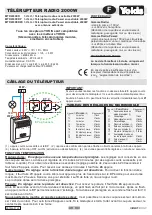
I.L. 40-385.1B
3-16
(5/92)
receives a trip or unblocking signal, the out-
put from the receiver operates the echo key
logic AND-65, providing both pilot relay (from
OR-40) and reverse-looking relay (from OR-
41) do not pick-up, and if system disturbance
is detected (
∆
V or
∆
I). Output of AND-65 will
key the weak terminal transmitter to the trip
or unblocking frequency via OR-18, AND-
35. On weak end reverse external fault, the
strong source end sends the trip (or unblock-
ing) frequency signal to the weak end, and its
pilot trip relay(s) is waiting to receive the
echo trip permission from the weak end.
However, at the weak end, the echo key logic
AND-65 will not operate, and because of the
reverse looking relay operation, it sends no
echo signal to the strong end. Both the
strong/weak ends will not trip on this external
fault.
(2) Weak end trip on internal fault (Figure 3-31)
The output of AND-65 (start echo keying) to-
gether with no output from OR-40 (pilot trip
relays), and with output from OR-44 (low
voltage condition) will satisfy AND-66; weak-
feed trip will be performed after 50 ms via
OR-2. The timer delay is for coordination be-
cause the voltage trip units are non-
directional.
3.23 LOGIC FOR RB ON BF SQUELCH
For a pilot system, the BFI signal can be used to stop
(for a blocking system) or start (for permissive
schemes) the carrier channel and allow the remote
terminal to trip should the local breaker fail to trip.
The problem is how to inhibit the remote terminal
from reclosing.
MDAR solves this problem by the RB on BF squelch
logic in the RI/RB software. This logic is as shown in
Figure 3-19, which includes AND-61A and a 132/0
ms timer. The logic will initiate RB at 132 ms (about
8 cycles) after the fault is detected by DI or DV, if the
pilot is enabled and the TRSL signal is received on
any 3-pole high speed trip operation (Zone 1 trip, pi-
lot trip or high set trip).
3.24 OPTIONAL OUT-OF-STEP (OOS) LOGIC
(Refer to Section 3.4.17.1)
3.25
OPTIONAL SINGLE-POLE TRIP (SPT)
LOGIC AND OUTPUTS (Refer to Section
3.4.18)
In addition to the foregoing features and options, the
MDAR Pilot Zone system includes many of the same
special functions as the Non-Pilot system, i.e.:
• RS-232C port (See Sections 4.3 and 4.7).
• Line voltage, current and phase angle monitor
(See Section 4.4.2).
• Reclosing initiation and reclose block outputs.
Refer to Section 5.3 for RI Guidance, except set
the relay to PLT = YES and apply a rated voltage
to PLT/ENABL terminals TB5/9(+) and TB5/10(-).
• Fault Locator function, and current change fault
detector (See Section 1.5).
• Self-check function (See Section 1.6).
3.26 MDAR Ordering Information
The MDAR equipment is identified by the Catalog
Number on the MDAR nameplate which can be de-
coded by using Table 3-1.
Содержание REL-300
Страница 30: ......
Страница 32: ......
Страница 33: ......
Страница 38: ......
Страница 39: ......
Страница 40: ......
Страница 41: ......
Страница 42: ......
Страница 43: ......
Страница 44: ......
Страница 45: ......
Страница 62: ......
Страница 63: ......
Страница 64: ......
Страница 65: ......
Страница 66: ......
Страница 67: ......
Страница 68: ......
Страница 69: ......
Страница 70: ......
Страница 71: ......
Страница 72: ......
Страница 73: ......
Страница 74: ......
Страница 75: ......
Страница 76: ......
Страница 77: ......
Страница 86: ......
Страница 87: ......
Страница 88: ......
Страница 116: ...I L 40 385 1B 6 14 5 92 Figure 6 1 Test Connection for Single Phase to Ground Faults Sheet 1 of 4...
Страница 117: ...I L 40 385 1B 5 92 6 15 Figure 6 2 Test Connection for Three Phase Faults 1502B51 Sub 1 Sheet 2 of 4...
Страница 118: ...I L 40 385 1B 6 16 5 92 Figure 6 3 Test Connection for Phase to Phase Faults 1502B51 Sub 1 Sheet 3 of 4...
Страница 131: ......
Страница 132: ......
Страница 133: ......
Страница 134: ......
Страница 135: ...I L 40 385 1B SD 6 5 92 Figure SD 2 MDAR Block Diagram sheet 1 of 1 Sub 1 1611C12...
















































